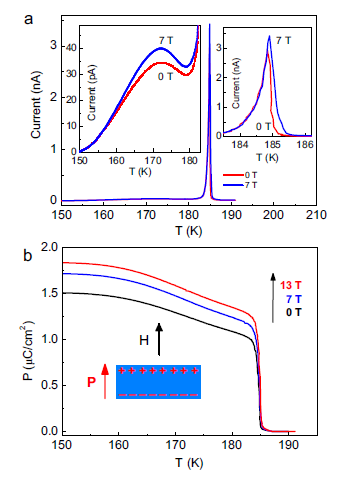
Multiferroic materials exhibiting both electric polarization and magnetic ordering have attracted a lot of research interest. Based on the magnetoelectric coupling effects in multiferroics, electric control of magnetism and magnetic manipulation of electric polarization can be achieved, which will provide additional freedom for developing novel functional devices.
The research group led by Prof. SUN Yang from Beijing National Laboratory for Condensed Matter Physics at the Institute of Physics, Chinese Academy of Sciences has focused on the study of multiferroics and magnetoelectric effects in the past several years. They have discovered large magnetoelectric effects in a variety of multiferroic materials, including the charge-ordered systems (Phys. Rev. B 79, 172412 (2009), Appl. Phys. Lett. 97, 092501 (2010) ); the hexaferrite with spiral magnetic structure (Appl. Phys. Lett. 100, 122901 (2012)); and the ferromagnet/ferroelectric heterostructure (Phys. Rev. Lett. 108, 137203 (2012)). Although the magnetoelectric effects have been intensively studied in a large number of inorganic materials, they have been rarely observed in organic systems.
Recently, Prof. SUN Yang’s group, in collaboration with Prof. WANG Shouguo and Prof. HAN Xiufeng from the State Key Laboratory of Magnetism at the Institute of Physics, Chinese Academy of Sciences, discovered the magnetoelectric effect in a metal-organic framework (MOF) with the formula of [(CH3)2NH2]Mn(HCOO)3. They grew single-crystal samples of the MOF with a solvothermal condition method. The dielectric measurement suggests that the MOF sample experiences a ferroelectric phase transition at 185 K due to the hydrogen bond ordering. Meanwhile, a antiferromagnetic ordering is observed below 8.5 K.
Therefore, this MOF system with both ferroelectricity and magnetic ordering at low temperature is a new class of muliferroic. Moreover, they found that the magnetic susceptibility of the MOF starts to deviate from the Curie-Weiss law at the ferroelectric transition temperature, suggesting an enhancement of short-range magnetic correlation in the ferroelectric state. Electron spin resonance study further confirms that the magnetic state indeed changes following the ferroelectric phase transition. Inversely, the ferroelectric polarization can be manipulated by applying high magnetic fields, going up with increasing magnetic field. This peculiar magnetoelectric coupling in the paramagnetic state in the MOF could be a consequence of the magnetoelastic effect that modifies both the superexchange interaction and the hydrogen bonding.
This work is the first experimental demonstration of the magnetoelectric effect in MOFs. It suggests that the hybrid metal-organic frameworks that combine the magnetism of metal ions with organic ferroelectricity open up a new route toward multiferroics and magnetoelectric effects.
This work was published on Scientific Reports 3, 2024 (2013). It was supported by the National Basic Research Program of China (Grant No. 2011CB921801) and the National Natural Science Foundation of China (Grant No. 11074293 and 51021061).
 |
| The magnetoelectric effect in a metal-organic framework with the formula of [(CH3)2NH2]Mn(HCOO)3. (a) The pyroelectric current as a function of temperature in different magnetic fields. (b) The electric polarization measured in different magnetic fields. (Image by Prof. SUN Yang et al.) |

86-10-68597521 (day)
86-10-68597289 (night)

52 Sanlihe Rd., Xicheng District,
Beijing, China (100864)

